Gallery
-
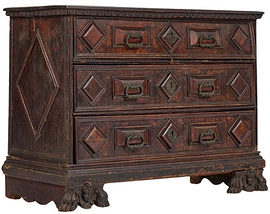
C-22
Stained Pine 17th Century Italian Walnut Commode
Cabinet features a fall-front writing surface opening to a fitted interior concealing twelve drawers.The rectangular moulded top above a frieze carved with Vitruvian scrolls on figural carved feet.
- width
- 56 in.
- height
- 42 in.
- depth
- 25 in.
-

SC-61
Elegant Bronze Sculpture Mask of a Woman
Elegant Bronze Sculpture Mask of a Woman. USA: circa 1935
- width
- 10.5 in.
- height
- 18.5 in.
- depth
- 9 in.
-
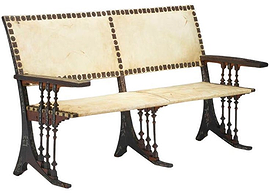
S-105
Rare and Important Walnut and Parchment Bench by Carlo Bugatti
Rare carved walnut bench by Carlo Bugatti upholstered with parchment, inlaid with pewter details and mounted with hammered copper decorations.Italy, c. 1906 literature: Carlo Bugatti au Musée d'Orsay, Massé, pg. 97 illustrates similar example
- width
- 65
- height
- 37
- depth
- 28
-
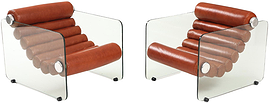
S-56
Pair of "Hyaline" Leather and Glass Chain Chairs by Fabio Lenci for Stendig
Pair of Leather and Glass Fabio Lenci Chain Chairs for Stendig. Bearing sticker 'Stendig Made in Italy" newly re-upholstered Italy: circa 1967 Provenance: Blackman Cruz Collection
- width
- 27
- height
- 27
- depth
- 35
- condition
- good overall condition newly re-upholstered
-
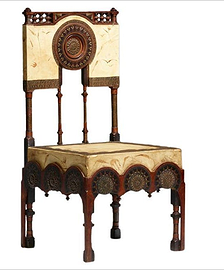
S-51
Rare Copper and Parchment Side Chair by Carlo Bugatti.
Rare carved walnut side chair by Carlo Bugatti upholstered with parchment and inlaid with pewter details and mounted with hammered copper decoration. Reffence: Beauty & Mischief: The Design Alchemy of Blackman Cruz, Blackman, Cruz and Stukin, pg. 132 illustrates similar example of Carlo Bugatti shown at Musée d'Orsay, Massé, Bugatti, Dejean, pg. 85 illustrates similar example. Italy: circa 1902 Provenance: Private collection Dallas Texas , Blackman Cruz collection Los Angeles
- width
- 18
- height
- 36.75
- depth
- 18
- condition
- Very good vintage condition. Surface wear consistent with age, original hand painted parchment .
-
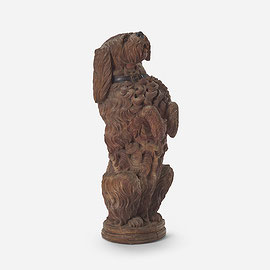
SC-31
Carved Black Forest Linden Wood Sculpture of a German Poodle Dog
Black forest life size carved linden wood sculpture of a standing German poodle dog with glass eyes. Germany: circa 1905 Private Collection Blackman Cruz.
- height
- 32
- diameter
- 10
- condition
- Very good condition, expected aging splits to the wood .
-
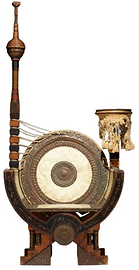
S-50
sold
Rare Throne Chair in Pewter Copper and Parchment by Carlo Bugatti
Rare and important carved walnut throne chair by Carlo Bugatti, upholstered with parchment and inlaid with pewter details and mounted with hammered copper decorations. Italy, circa 1902. In 1888 when Bugatti exhibited at the Italian Exhibition in Earls Court, London, from which nine pieces of his furniture were illustrated in the Queen, The Lady’s Newspaper. Bugatti made a strong impression on the British, being awarded a diploma of honour and subsequently receiving one of his most notable interior design commissions, the bedroom for the English society figure Cyril Flower, Lord Battersea. The first example of this chair can be seen in one of the rooms designed by Bugatti for Lord Battersea ( see period photos ). A similar example can be seen in the book Carlo-Rembrandt-Ettore-Jean Bugatti, Dejean, pg. 44 See current image of current 2024 exhibition: "Monticelli, précurseur de l'impressionnisme & Bugatti, une dynastie de créateurs" in Uzès France. Provenance: Blackman Cruz : Beauty and Mischief , private collection of David Cruz Los Angeles, acquired in Mexico City about 30 years ago by David Cruz .
- width
- 30
- height
- 61
- depth
- 23
- condition
- Very good original condition, retaining its original cotton tassel work which shows wear and fragility, original hand painted parchment showing normal wear and patination considering age and use.
-
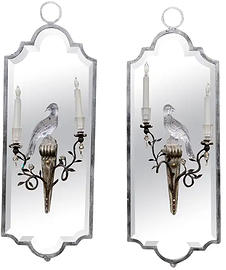
M-28
Rare Pair of Maison Bagues Parrot Girandoles Mirrors
Rare Pair of Maison Baguès parrot girandoles mirrors fitted with typical moulded and etched glass parrot sconce figures.Shaped beveled mirrored glass set in silvered iron frames.
- width
- 14
- height
- 39
- depth
- 4
-

C-09
18th Century Painted Blue Italian Commode
An 18th century Italian commode with serpentine front and shaped sides, having two large drawers over shaped apron standing on cabriole legs ending in hoof feet. Original contemporary figural scenes on front of drawers and sides of commode and decorative vine and leaf decoration throughout over attractive blue background. Italie: circa 1750
- width
- 55
- height
- 37.5
- depth
- 24.5
-
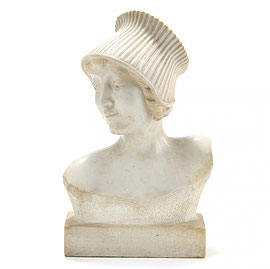
SC-20
Art Deco Period White Statuary Marble Bust of a Young Lady
Art Deco Period White Statuary Marble Bust of a Young Lady incised "ANIEV" to shoulder. From the Collection of Professor Roberto Severino, Washington, D.C. France: circa 1930
- width
- 12.
- height
- 19.75
- depth
- 8.5
-
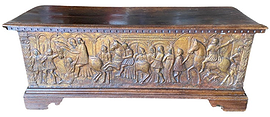
C-02
CASSONE WITH GOLDEN IN PASTIGLIA DECORATION
CASSONE with golden in pastiglia decoration with polychrome and walnut highlights. Facade decorated with a triumphal procession with horsemen, pages, soldiers and numerous characters against a background of architecture with arched arches and pilasters. Tuscany, 15th century
-

T-138
Arts&Craft Leather Top Octagonal Center Table
A substantial Arts & Crafts center table with a leather covered octagonal top fitted with large patinated brass nails at the edges, standing on four tapered square oak legs joined by X-stretcher. American, circa 1900.
- width
- 41
- height
- 29.25
- depth
- 41
-
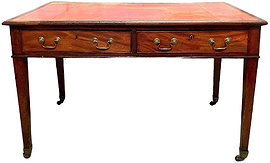
D-05
George III Period Mahogany Desk
George III Period Mahogany Desk two drawer resting on on square tapered legs castors and the top inset with gold-tooled red leather. England: circa 1790
- width
- 48 in.
- height
- 29.75 in.
- depth
- 27.5 in.
-

T-128
Oak Circular Side Table the Manner of Jacques Adnet
Oak Circular Table the Manner of Jacques Adnet. France: circa 1950
- height
- 20.5
- diameter
- 26.25
-
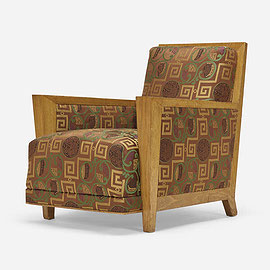
S-05
Art déco oak armchair in the manner of Jacques Adnet
Art déco oak armchair in the manner of Jacques Adnet with asian style fabric
- width
- 28 in.
- height
- 30.5 in.
- depth
- 33 in.
-
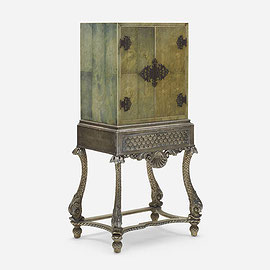
CH-03
Rare Shagreen Covered Cabinet on Stand by Asprey & Co
Rare precious shagreen covered cabinet on silver gilt carved wood stand by Asprey & Co of London. The cabinet design is modelled after an 18th century Chinese export cabinet usually decorated with lacquer work, it is covered with pale green shagreen, featuring two doors fitted with typical Chinese style brass hinges and central escutcheon all resting on a carved and silver-gilt Grotto style base. England: circa 1920
- width
- 26 in.
- height
- 49.25 in.
- depth
- 18 in.
-
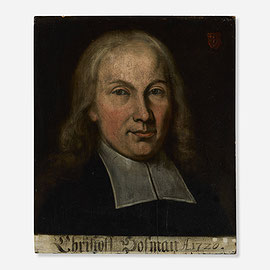
P-43
Oil on Panel of Gentleman Portrait
Oil on panel of gentleman portrait Inscribed to lower edge: 'Christoff Sofman A 1720'. Continental Europe
- width
- 13.5 in.
- height
- 16 in.
- depth
- 1 in.
-
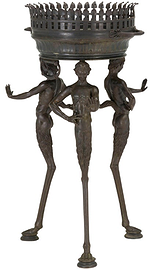
F-34
Bronze Pompeian Athénienne-Jardinière attributed to Sabatino De Angelis & Fils
Bronze Pompeian Athénienne-Jardinière attributed to Sabatino De Angelis & Fils The present work was inspired by a Pompeian brazier that was buried in 78 A.D. and excavated later. as three satyrs holding aloft a handled dish with pierced gallery The form was originally used in ancient Roman baths to provide heating, and widely reproduced in the 18th-19th century as a Grand Tour souvenir. Italy: circa 1850
- height
- 35.25
- diameter
- 19.25
-
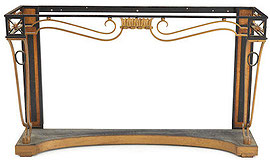
T-85
Art Deco Gilt and Painted Wrought Iron Console Table
Art Deco gilt and painted wrought Iron console table France: circa 1935
- width
- 49.5
- height
- 30
- depth
- 15 in.
-
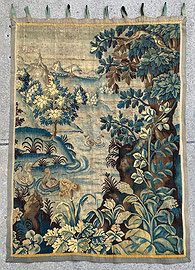
P-50
on hold
18th Century Aubusson tapestry
French 18th century Aubusson tapestry, verdure decorated with ducks in a pond.
- width
- 58
- height
- 79
-
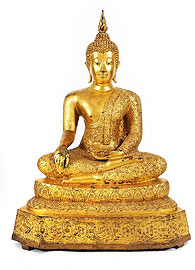
SC-13
Large Gilt Bronze Thai Buddha Sculpture
Large Gilt Bronze Thai Buddha Sculpture Thailand: circa 1970 Provenance: Petit Musée Dan Klein Collection: Mr Hemming Montreal
- width
- 29
- height
- 38
- depth
- 16
-
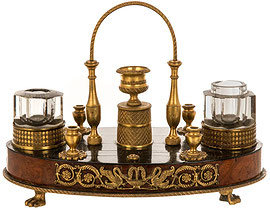
NW-79
Rare Inkwell in Burled Ash Ebony and Gilded Bronze from the First Empire Period.
Rare inkwell in ash burl, ebony and gilded bronze from the First Empire period. decorated with four pen holders, candlestick and a gilded bronze frieze with swans and arabesque motifs France: circa 1810
-
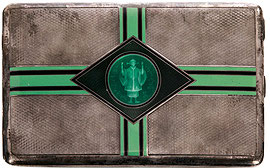
NW-78
Cigarette Case from the Art Deco Period in Silver and Enamel with Chinese Decoration
Cigarette case from the Art Deco period in silver and enamel with Chinese Sage and proverb Hallmark: boar's head in 800 silver. France: circa 1930
- width
- 5.5 in.
- depth
- 3.5 in.
-

NW-77
Qing Dynasty Blue and White Decorated Chinese Export Porcelaine Sprinkler,
A Chinese Qing Dynasty blue and white blue porcelain "rose water" sprinkler, fitted with silvered metal filigree work, the stopper decorated with a coral mounted finial, made to export to the Orient. China Kangxi period, circa1700
- height
- 9.75